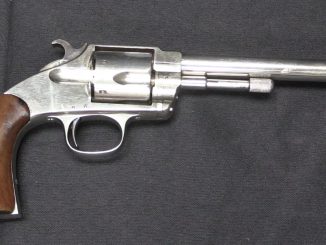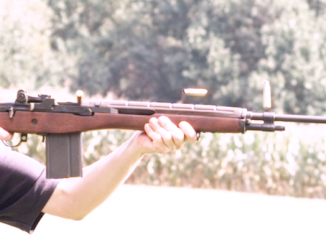This is lot #210 in the upcoming RIA Premier Auction. It was scheduled for April, but has been postponed – check their web site for upcoming Online Only auctions every month, though!
Hopkins & Allen was founded in 1867 based on the factory of the defunct Bacon Manufacturing Company. Its founding partners were pretty savvy businessmen, and would become quite successful in the 1870s and 1880s working as an OEM parts manufacturer for a variety of brands (including Merwin & Hulbert and Evans) as well as making their own line of firearms. However, the predominant reputation of the brand was that of cheap pocket handguns, and this would cause them problems when they tried to introduce a martial style revolver.
This new revolver was the XL No. 8, introduced in 1877. It was offered in the Army pattern in either .44 Henry or .44 WCF (aka .44-40) and also Navy and Police patterns in .38 Rimfire. None would be successful, with just a few hundred of each type made before production ended in 1885. Customers looking to spend substantial money on a large, high-quality revolver simply didn’t look to Hopkins & Allen – they went to Colt or Smith & Wesson.
Mechanically, the XL No. 8 was a solid-frame revolver with a loading gate copied directly from the Mersin & Hulbert and an ejector rod that stored under the barrel. Capacity was 6 rounds, with barrel lengths offered from 4.5 inches to 7 inches and sights much in the style of the Colt SAA.




“Mersin & Hulbert”
Who is Mersin & Hulbert? Is that some company making knock-offs of Merwin & Hulbert revolers?
Spelling errors happen when you rush the article!
That’s why I use Spallchick.
I think this is the first time I have this reason for why a weapon became forgotten.
… seen this reason …
This story reminded me about volskwagen Phaeton automobile:
https://en.wikipedia.org/wiki/Volkswagen_Phaeton
it was premium-class automobile, but did not sell well, as brand recognition of VW (there is Volks for reason!) combined wit “premium” did result in dissonance.
That was a great car. Swan song of the VW President. Remember when it came out and being impressed. BUT, did not buy it.
Not because it was a VW, but because I didn’t do sedans back then.
I think, thanks to the low position of the barrel, they made a good sports revolver.
(If there are sports 44-caliber revolvers)
But in for an army assignment, without double action, they did not have a single chance.
Actually, until the Colt Model 1892 was introduced, the Army was firmly committed to single-action revolvers. The cavalry were the primary handgun users, and they didn’t want a double-action revolver (or later a semi-automatic pistol) due to the potential for accidental discharges on horseback.
The reason the H&A revolver failed to gain military contracts was, quite simply, the Colt Model 1873. The Army was perfectly satisfied with it (as indeed they should have been), and saw no reason to introduce yet another service pistol, especially in a caliber that was not used by any other issue arm (.44 WCF).
At the time, the Army had finally gotten rid of the last of the S&W Schofield revolvers (which, contrary to S&W “official history”, almost nobody liked) that fired yet another “substitute standard” cartridge, the .45 S&W, and having two different service sidearms requiring two different cartridges was a bridge the Army preferred not to fall off of a second time.
cheers
eon
The boring but practical reasons for the US Army to do a rational decision (getting rid of a revolver and cartridge that wasn’t as good as claimed) during this period also made for some irrational (in hindsight) decisions. Labeling ALL machine guns as impractical clunky money sinks after a few Gatling crews jammed up (through panic) and got their butts handed to them by spear-wielding natives seems a bit odd. For that matter, the later idea of refusing to look at the Maxim machine gun family owing to the Gatling being “good enough” made for some embarrassing encounters where the Gatling crews were massacred by Maxim guns before they could set up! Yes, FYI, this is just an exaggeration!
Incidentally, the recent BBC three-episode miniseries of H.G. Wells’ War of the Worlds, set in 1904, shows the British regulars using a hand-cranked ten-barrel Gatling Gun.
No. Just…no.
I suppose Britain’s Draconian anti-everything-that-looks-vaguely-like-a-firearm (and books on same) laws probably had something to do with it. But let’s face it, the British Army replaced the Gatling and Gardner guns with Maxims not long after Isandlwana and Majuba Hill.
Somebody needs to do their research better next time.
cheers
eon
But was not older guns, like Gardners, keep in storage?
No, by 1900 they had all been retired (i.e. mostly scrapped) because they were chambered for the old blackpowder .577/.450 Martini-Henry cartridge.
There was no economical way to convert them to the new standard 0.303in Cordite round, and like the U.S. Army the British Army wasn’t interested in having to maintain stores of two different cartridges for frontline units.
By 1901, even Territorial Reserve (we’d call them “National Guard”) units in Britain itself were fully re-equipped with 0.303in weapons, including Maxim heavy MGs.
Incidentally, the show was set in 1904 because in the novel, Wells stated that the invasion was thrown in during a summer opposition (closest approach) of Mars to Earth (about 40 million miles), and any astronomy geek will tell you that the nearest opposition of that proximity to 1897 (when Wells wrote the book) was in July and August of 1904.
So at least they got that much right.
cheers
eon
You said Norwich correctly!
Hopkins and Allen weren’t the Hi-Point of the old west, that would imply they worked!
mr jatt Mp3 New Punjabi Song,Single Tracks Latest song download also Listen Latest Music Albums Online in High Quality at Mrpendus.in
mr jatt
Thanks For This Great Article. May You Bring This More in Future. Mplyrics
Greetings Ian, I just inherited the H & A XL 8. I came across this article as I’m starting to do my homework on the piece. But it’s in the almost miniscule .32 Centerfire Chambering. Is it possible they produced the same pistol in such a huge caliber span?
Cheers
Lt Col Jet